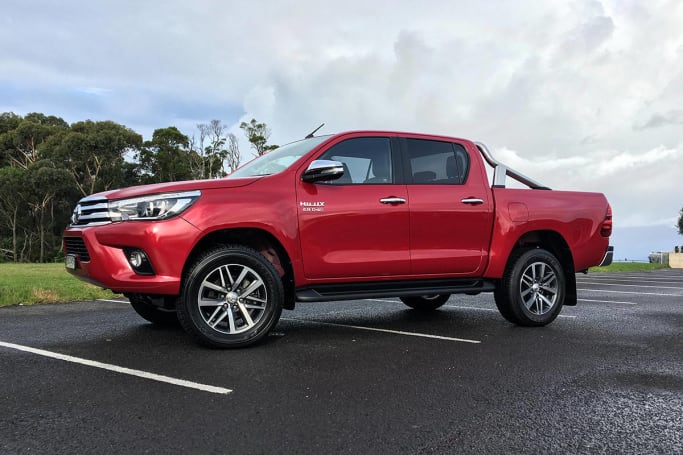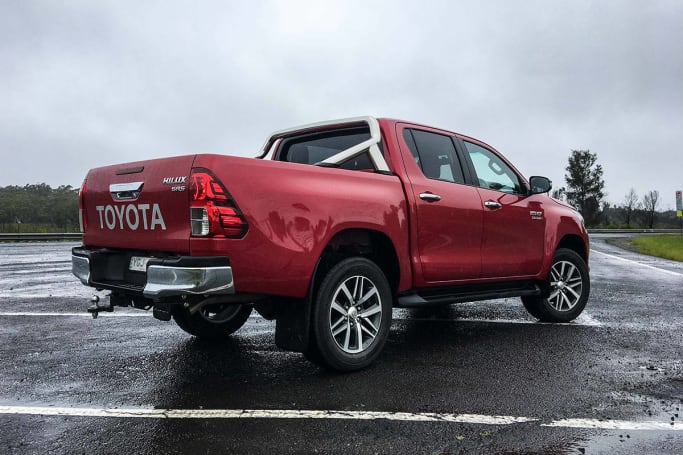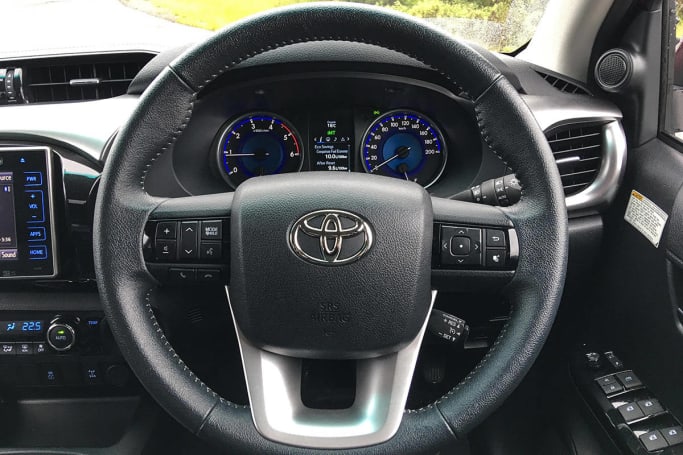
Isuzu D-Max 2017 review
Richard Berry road tests and reviews the updated Isuzu D-Max, with specs, fuel consumption and verdict at its Australian launch in Queensland.
Browse over 9,000 car reviews

We all know the Toyota HiLux 4x4 is one tough truck, and the new generation GD follows the trend. We also know it can carry quite a load in the rear tray, but what is it like when it needs to drag something behind it?
With a healthy tow rating of 3.5 tonnes for manual-equipped 4x4s (up by a tonne on the previous generation HiLux), which covers all but the very largest caravans, horse floats, and boats, the HiLux is rated to haul a large load and do it easily.
In case you're wondering, the auto is rated to 3200kg.
We decided to strap a more typically sized load to the back of an SR5 dual cab, consisting of a light car on a dual axle trailer. Tested over two days, we also recorded actual weights and fuel figures of the rig. Is the Toyota as tough as its maker likes to think it is? Well, let's see.
| Toyota HiLux 2017: SR5 (4X4) | |
|---|---|
| Safety rating | |
| Engine Type | 2.8L turbo |
| Fuel Type | Diesel |
| Fuel Efficiency | 7.6L/100km |
| Seating | 5 seats |
| Price from | $44,990 |
Even though the new-shape HiLux bears little resemblance to its forebear, some elements have survived the transition to the GD shape.
One of those is the stepped rear bumper, which incorporates a scooped section covered in grippy rubber that allows access to the rear tub without having to lower the tailgate.

The factory fitted towing drawbar sits neatly beneath the bumper, though the square hitch receiver does jut out slightly from the rear profile; watch those shins!
The tub's tailgate can be lowered without touching the trailer, even though it has an additional handle welded on over the tow ball hitch itself.

The factory-fitted tow bar on the HiLux is mounted at a perfect height to be able to use the vast majority of trailers on the market. If a tow bar is mounted too high, then a step-down insert for the tow ball will be needed.
A flat-pin electrical connector is also fitted, along with a brake controller with the dial under the driver's right hand.

Speaking of brake controllers, the notion of a braked trailer is quite an important one to understand. Larger trailers are equipped with an electric braking system that can also be controlled within the tow car's cabin via a small dial. These systems don't come fitted from the factory, and they need to be correctly installed by an auto electrician.
The SR5 is designed more to be used in the wilds of suburbia than in the mining pits of the Pilbara.
The brake force dial essentially turns the braking performance of the trailer up or down depending on the conditions. If the trailer is fully laden and descending a hill, you will need to turn more brake bias towards the rear of the car to give it stronger braking.
However, if the trailer is empty, you can turn the brake force down to reduce the chance of it locking tyres and skipping when coming to a stop. It's very important that the driver of the tow vehicle understands how to use the brake force dial, so manuals should be read and questions should be asked.
Backing up to the trailer is made easy with extra lines and a small crosshatch on the reversing camera screen which shows exactly where the centre line of the rear of the car is, and allows for simple reversal right up to the tow ball.

The HiLux's cabin ergonomics are well chronicled, but suffice it to say the five seater is comfortable up front, especially in SR5 form, with cup holders in the console and bottle holders in the doors.
There's an 'Intelligent Manual Transmission' mode switch to help match revs on downshifts, too, which is a neat feature. The multimedia system is starting to show its age, though, and it misses out on Apple CarPlay and Android Auto.
The SR5 is the flagship of the large HiLux fleet, and sells for $54,390 before on-road costs. It runs a 2.8-litre four-cylinder turbo diesel engine that's new for the fourth generation HiLux, backed by a six-speed manual gearbox.
The SR5 is designed more to be used in the wilds of suburbia than in the mining pits of the Pilbara, and has 18-inch rims, leather interior trim, height and reach-adjustable steering with controls on the wheel, a 7.0-inch touchscreen multimedia system, auto lights, satellite navigation and carpets. In a ute!
On the surface, it's a heck of a lot of money for a relatively simple, utilitarian device like a ladder-frame ute, but the dosh goes into over-engineering the HiLux against the perils of genuine hard work off road.
The SR5 battles for the class win against Ford's Ranger WildTrak, Holden's Colorado LT-Z, the Mitsubishi Triton Exceed and Isuzu's D-Max LS-U.
The towing kit fitted to the test car is a Toyota genuine parts bundle that was, according to Toyota, designed five years before the HiLux was even released, as part of the chassis build. It comprises the tow ball, tongue and wiring bundle, and retails for $580. The HiLux comes standard with a draw bar to suit the kit.
The HiLux's (1GD-FTV) four-cylinder single turbo-diesel delivers its maximum power of 130kW at 3400rpm and peak torque of 450Nm between 1400 and 2600rpm, and it's been built with towing in mind, thanks to updates to key parts like radiator internals.
Linked to the six-speed manual, it's a relatively quiet and pleasingly smooth, tractable engine to use. The manual, as mentioned, has a rev-matching button that works to smooth downchanges out, while the clutch action is comfortable and predictable.
Before we attached the trailer, a 100km stint on a brimmed tank indicated a fuel usage of 9.1L/100km on the dash and a top up of 10 litres (so 10.0L/100km)
We towed the outfit for 519km, and had to refuel at around the 447km mark, with the HiLux drinking 68L of diesel. With a fuel tank of 80L, this equals a towing economy figure of 15.2L/100km.
With plenty of rolling hills and lot of inclement weather (including nasty headwinds), this test was as far from a lab as you can get, and is a fair score considering the conditions. This score could be improved in fairer conditions, for sure.
While it's not quite accurate to call the 3500kg load towing ability disingenuous, it's worth noting if you have a tow toy that's pushing that total, a couple of key figures come into play.

Let's quickly recap; a vehicle's kerb weight is the mass of a vehicle complete with all fluids and a full tank of fuel, but with no passengers or cargo.
On top of that, all vehicles have a gross vehicle mass (GVM) assigned to them, which is basically the kerb weight of the car plus its payload, including humans.
The next figure to consider is the gross combined mass (GCM) which, as you can imagine, is the combined total of the car, the payload, the trailer, the trailer's load and everything else aboard.
We opted for a dual axle dovetail car trailer to tow our small Suzuki Ignis Sport race car to two venues across New South Wales over two days.
In this case, the kerb weight of the HiLux is listed at 1930kg (ours weighed 2120kg at a commercial weighbridge, thanks to the tow pack and leather interior), its GVM is listed as 2780kg and its GCM as 5850kg.
We opted for a dual axle dovetail car trailer to tow our small Suzuki Ignis Sport race car to two venues across New South Wales over two days. Using the same weighbridge, the dovetail trailer came in at 790kg. Our little race car, meanwhile, came in at 840kg.
Using our high school maths to the best of our ability, that equals a total payload of 1640kg.
In our case, while our actual trailer and load wasn't too heavy, we were also carrying 175kg of gear including spare wheels, tools, jerry cans and spares.
And the weight of the passengers should be considered. In our case, total passenger weight was around 190kg, but of course a five-seat car can theoretically carry anywhere up to 600kg of passenger load.
So, our 2120kg HiLux, plus its 1640kg of car and trailer, 190kg of humans and 150kg of gear actually weighs 4100kg all up.
Say, for example, your trailer actually weighs 3500kg - this is a bloody large trailer, by the way – that figure jumps to 5960kg, and you're officially overweight. The heavier your trailer, the more your ability to carry people and luggage is reduced.
Taking all of our payload and trailer weights into consideration, the HiLux is left with a reserve of approximately 1750kg, which means there should be plenty of performance in reserve for the long trips we have planned.
The HiLux is fitted with longer leaf springs set wider apart in the rear to cope with its claimed 920kg payload capacity, and this stiffer suspension set up really helps turn the HiLux into a very good tow vehicle.
Without a trailer on board and in two (rear)-wheel drive mode, the HiLux can be skittish and unsettled in the rear end, particularly in wet conditions, but there was none of that in evidence once the trailer was on, even through the torrential downpours that drenched Sydney in early autumn.
Helping here is the standard trailer sway control built into the HiLux's stability control system.
The HiLux towed the oddly shaped, un-aerodynamic load with little fuss.
There were a couple of issues of note, though. Firstly, the combination picked up an odd vibration at around 90-95km/h, which even shifting the car on the trailer couldn't iron out.
And while the strength of the 2.8-litre turbo-diesel teamed with the slick-action (for a 4x4 ute, at least) manual was most useful up hills, it didn't provide much in the way of engine braking on the way back down.
Sixth gear is best kept for long, gentle level-to-downhill runs; climbing a rise in top gear with load on board saw you reaching for the shifter sooner rather than later.
Overall, though, the HiLux towed the oddly shaped, un-aerodynamic load with little fuss, and allowed us to stay with the flow of freeway traffic without drama.
Basic Warranty
3 years / 100,000 km warranty
ANCAP Safety Rating

Toyota built the HiLux to achieve a maximum five-star ANCAP safety rating in order to boost its chances of sales in the primary industry sector. It comes with six air bags as standard, but no driver aids like AEB or blind spot monitoring.
Toyota offers a fixed service regime for the HiLux of $240 per service for the first six services, up to a total of six over three years or 60,000km. Service intervals of 12 months or 10,000km are suggested.
The warranty is three years or 100,000km.
We didn't expect the HiLux to be a bad tow vehicle, but we are surprised at just how good it really is. It excelled at pulling a medium-sized, yet awkwardly shaped load over a distance of more than 500 kilometres and, at times, treacherous weather conditions.
| Vehicle | Specs | Price* | |
|---|---|---|---|
| Workmate | 2.4L, Diesel, 5 SP MAN | $21,670 – 27,390 | 2017 Toyota HiLux 2017 Workmate Pricing and Specs |
| Workmate (4x4) | 2.4L, Diesel, 6 SP AUTO | $34,760 – 41,360 | 2017 Toyota HiLux 2017 Workmate (4x4) Pricing and Specs |
| SR | 2.8L, Diesel, 5 SP MAN | $23,650 – 29,260 | 2017 Toyota HiLux 2017 SR Pricing and Specs |
| SR (4X4) | 2.8L, Diesel, 6 SP MAN | $36,300 – 43,230 | 2017 Toyota HiLux 2017 SR (4X4) Pricing and Specs |
| Design | 8 |
|---|---|
| Practicality | 8 |
| Price and features | 7 |
| Under the bonnet | 7 |
| Efficiency | 7 |
| Driving | 7 |
| Safety | 8 |
| Ownership | 8 |
$15,999
Lowest price, based on 799 car listings in the last 6 months